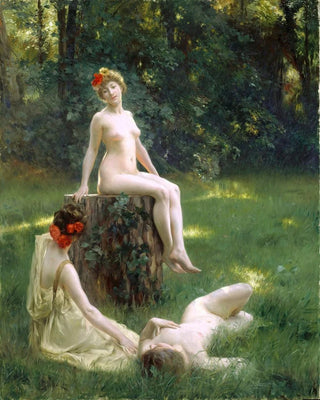Art print | The Glade - Julius LeBlanc Stewart


View from behind

Frame (optional)
In the fascinating world of art, certain works stand out for their ability to evoke deep emotions and transport the viewer into a realm of timeless beauty. "The Glade" by Julius LeBlanc Stewart is one of those pieces that capture the very essence of nature and light. This artwork, which belongs to the Impressionist movement, invites serene contemplation, where each brushstroke seems to whisper the secrets of a sun-drenched forest. Light plays a central role in this composition, creating interplay of shadows and reflections that animate the landscape. When viewing this art print, one feels an immediate connection with nature, an invitation to lose oneself in the tranquility of a glade.
Style and uniqueness of the work
Stewart's style is characterized by an exceptional mastery of color and light. In "The Glade," he manages to capture the glow of the sun filtering through the foliage, creating vibrant shades of green that seem to vibrate under the gaze. Every element of the painting, from majestic trees to delicate grasses, is treated with meticulous attention, revealing the richness of details that define his work. This art print does not merely depict a landscape; it evokes an atmosphere, a sense of peace and natural beauty. The composition is balanced, guiding the eye across the piece while leaving room for imagination. Stewart, through his Impressionist approach, succeeds in transforming a simple moment of nature into a deeply immersive visual experience.
The artist and his influence
Julius LeBlanc Stewart, 19th-century American painter, made a name for himself in the art world thanks to his undeniable talent and innovative approach. Influenced by European masters, he developed a style that combines Impressionist sensitivity with refined technique. Stewart traveled across Europe, absorbing artistic influences that would shape his work. His passion for nature and his unique perspective on the world led him to create paintings that transcend time. By exploring themes of everyday life and natural beauty, he paved the way for many contemporary artists. His legacy

Matte finish

View from behind

Frame (optional)
In the fascinating world of art, certain works stand out for their ability to evoke deep emotions and transport the viewer into a realm of timeless beauty. "The Glade" by Julius LeBlanc Stewart is one of those pieces that capture the very essence of nature and light. This artwork, which belongs to the Impressionist movement, invites serene contemplation, where each brushstroke seems to whisper the secrets of a sun-drenched forest. Light plays a central role in this composition, creating interplay of shadows and reflections that animate the landscape. When viewing this art print, one feels an immediate connection with nature, an invitation to lose oneself in the tranquility of a glade.
Style and uniqueness of the work
Stewart's style is characterized by an exceptional mastery of color and light. In "The Glade," he manages to capture the glow of the sun filtering through the foliage, creating vibrant shades of green that seem to vibrate under the gaze. Every element of the painting, from majestic trees to delicate grasses, is treated with meticulous attention, revealing the richness of details that define his work. This art print does not merely depict a landscape; it evokes an atmosphere, a sense of peace and natural beauty. The composition is balanced, guiding the eye across the piece while leaving room for imagination. Stewart, through his Impressionist approach, succeeds in transforming a simple moment of nature into a deeply immersive visual experience.
The artist and his influence
Julius LeBlanc Stewart, 19th-century American painter, made a name for himself in the art world thanks to his undeniable talent and innovative approach. Influenced by European masters, he developed a style that combines Impressionist sensitivity with refined technique. Stewart traveled across Europe, absorbing artistic influences that would shape his work. His passion for nature and his unique perspective on the world led him to create paintings that transcend time. By exploring themes of everyday life and natural beauty, he paved the way for many contemporary artists. His legacy






